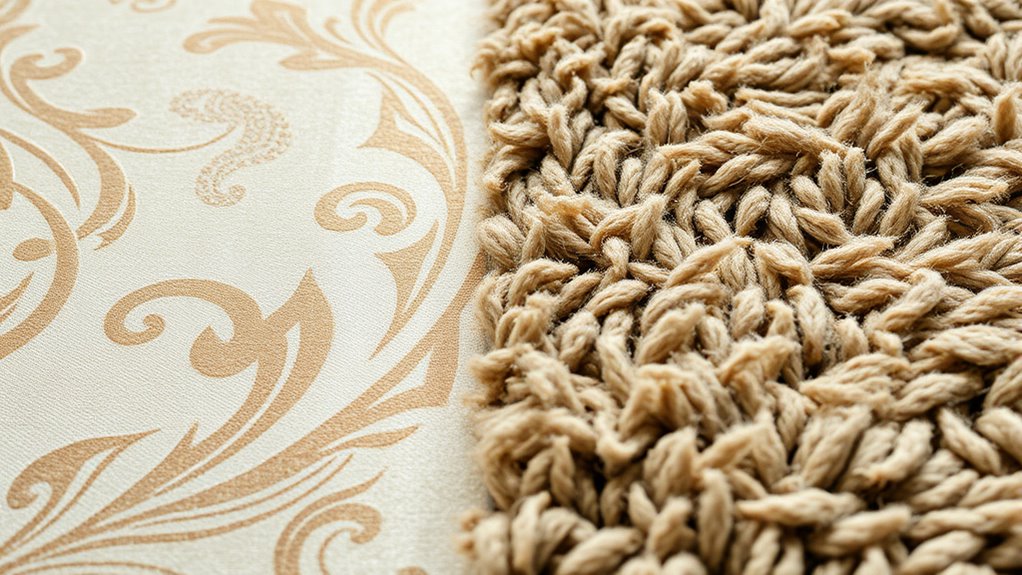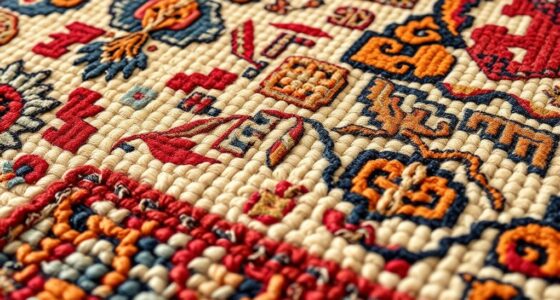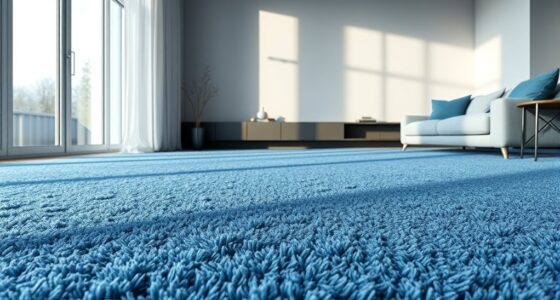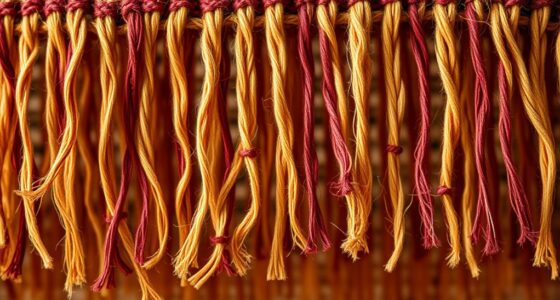Silk rugs are elegant with a natural, luminous sheen but are more delicate and prone to wear, needing careful handling and maintenance. Wool rugs are durable, resistant to foot traffic, and have a softer, matte finish that hides wear over time. They’re easier to clean and more forgiving in high-traffic areas. If you want to uncover detailed differences in durability, sheen, and upkeep, just keep exploring for a clearer picture.
Key Takeaways
- Wool rugs are more durable and resistant to wear, making them suitable for high-traffic areas, while silk rugs are more delicate and prone to damage.
- Silk rugs have a natural, luminous sheen that enhances color vibrancy, whereas wool rugs typically have a matte, softer finish.
- Wool rugs are easier to clean and maintain, handling spills and stains better than delicate silk rugs, which require gentle, specialized cleaning.
- Silk’s high sheen and fine fibers offer a luxurious appearance with vibrant colors, but they age faster and are more susceptible to fraying.
- Wool rugs are generally more cost-effective, longer-lasting, and better suited for everyday use, while silk rugs are a premium investment with a refined aesthetic.
Material Composition and Textural Differences

Silk and wool rugs differ markedly in their material composition, which directly influences their texture. Silk fibers are known for their exceptional strength, allowing for delicate, intricate weaves that feel smooth and luxurious underfoot. Wool, on the other hand, has a more elastic fiber structure, offering a softer, more cushion-like texture with natural resilience. This difference in fiber strength results in distinct texture variations: silk rugs often have a sleek, glossy surface with fine detail, while wool rugs tend to be thicker and more plush, providing a cozy feel. Your choice depends on the desired tactile experience—silk offers a refined, smooth touch, whereas wool provides a warm, textured surface. Both materials shape the overall feel and appeal of the rug in your space. Additionally, understanding the material properties can help in selecting the most durable and suitable option for your lifestyle. Recognizing the market trends in rug materials can further guide your decision-making process to ensure longevity and style. When considering durability, wool generally withstands wear and tear better than silk, making it ideal for high-traffic areas. It is also important to consider maintenance requirements, as silk rugs often need more careful cleaning to preserve their delicate fibers. Furthermore, advances in fiber treatments can enhance the durability and stain resistance of silk rugs, broadening their practicality for everyday use.
Visual Appeal and Sheen Attributes
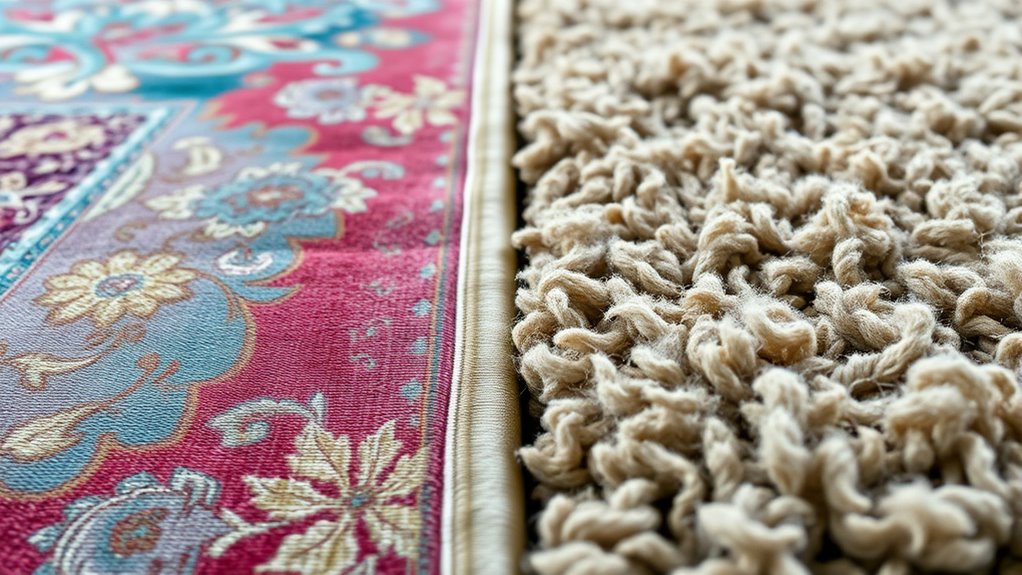
You’ll notice that silk rugs have a natural sheen that catches the light beautifully, making them look more luminous. Wool rugs reflect light differently, offering a softer, more muted glow. This variation in light reflection considerably affects how bright and vibrant each rug appears in your space. Additionally, understanding the role of attention in creative practice can help you appreciate how the subtle differences in sheen influence the overall ambiance and visual appeal of your interior decor.
Natural Sheen Differences
While both silk and wool rugs offer distinctive visual appeal, their natural sheens create noticeably different impressions. Silk rugs tend to have a high, luminous sheen that enhances color vibrancy, making hues appear richer and more vivid. This sheen gives silk rugs a luxurious, almost glowing quality that draws the eye. Wool rugs, in contrast, have a softer, more matte finish, which provides a cozy, understated elegance. The sheen in wool rugs doesn’t reflect light as strongly, resulting in a more subdued look. Additionally, silk’s natural sheen can influence scent retention, often holding fragrances longer and more vividly. Wool, with its more muted shine, tends to absorb and retain scents differently, contributing to a different sensory experience. These natural sheen differences markedly impact the visual and aromatic appeal of each rug type. Moreover, understanding the sheen attributes of each material can help in selecting the ideal rug to match your decor and lifestyle.
Light Reflection Qualities
The way light reflects off a rug’s surface considerably influences its overall visual appeal and perceived sheen. Silk rugs have highly flexible fibers that catch light beautifully, creating a luminous glow. Their smooth surface enhances dye absorption, resulting in rich, vibrant colors that reflect light evenly. Wool rugs, on the other hand, have less fiber flexibility, leading to a more matte finish and softer sheen. Their dye absorption varies, often producing a warm, muted glow rather than a bright shine. This difference in light reflection gives silk rugs a more luxurious, shiny appearance, while wool rugs tend to look more subdued and cozy. Your choice depends on whether you prefer a glossy, eye-catching sheen or a more understated, textured look.
Visual Brightness Impact
The visual brightness and sheen of a rug directly influence its overall aesthetic and the ambiance it creates in a space. Silk rugs typically exhibit higher dye penetration, which enhances their vibrant colors and reflective qualities, making them appear brighter. Wool rugs often have a denser fiber structure, affecting how light interacts with their surface. Consider these factors:
- Higher dye penetration in silk results in more vivid, luminous hues.
- Increased fiber density in wool can dull the sheen but add depth.
- Silk’s natural sheen amplifies light reflection, boosting brightness.
- Wool’s matte surface offers a softer, subtler glow.
Resistance to Wear and Tear
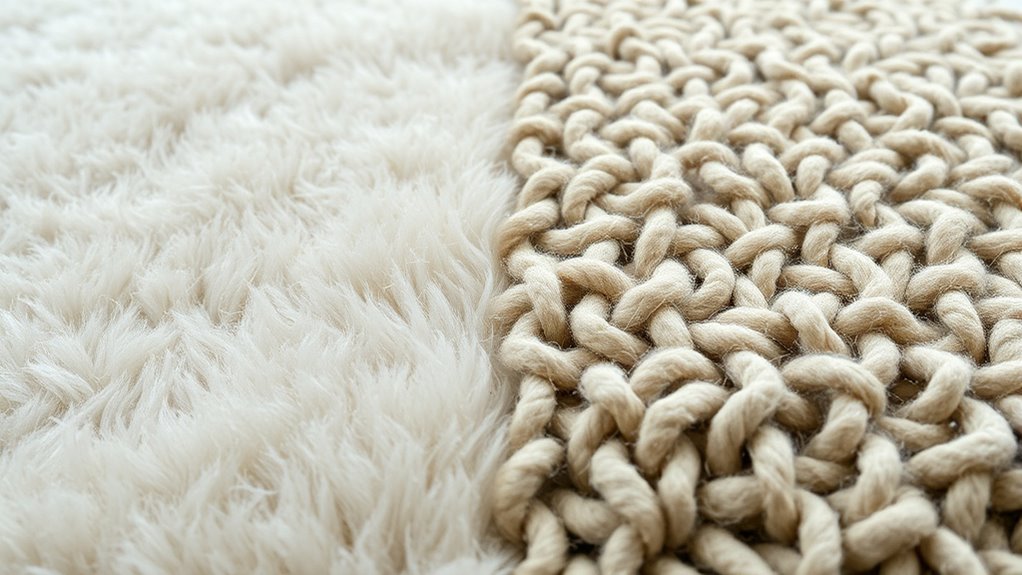
Silk rugs are delicate and tend to show wear more quickly than wool rugs, especially in high-traffic areas. Their fiber strength is lower, making them more prone to fraying or damage over time. Silk’s susceptibility to pests, such as moths, also increases the risk of damage, particularly if not properly maintained. Wool rugs are naturally more durable, with stronger fibers that resist wear better. They withstand foot traffic and minor abrasions more effectively, maintaining their appearance longer. Additionally, anti-pest treatments can help protect silk rugs from damage caused by pests. Proper maintenance practices are essential to prolong the lifespan of delicate silk rugs and keep them looking their best, as fiber strength plays a crucial role in overall durability. Understanding material properties can help in selecting the right rug for high-traffic areas and ensuring its longevity. Moreover, using protective pads can reduce the impact of foot traffic on both types of rugs, extending their life.
Ease of Cleaning and Stain Management
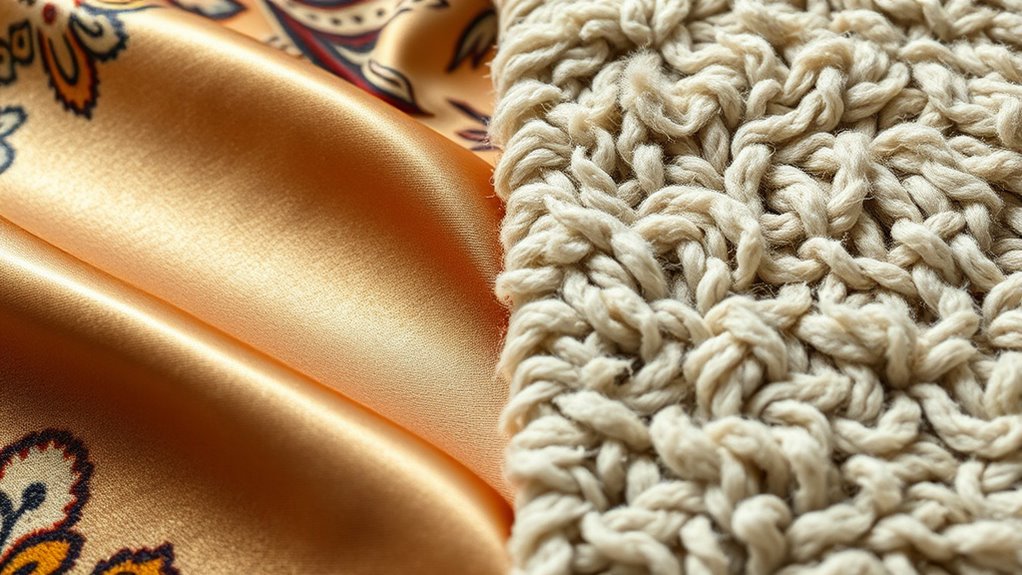
While silk rugs are more delicate and prone to wear, their maintenance also presents unique challenges when it comes to cleaning and stain removal. Silk’s lower stain resistance means spills can set quickly if not addressed promptly. To manage this effectively, consider these tips:
Silk rugs are delicate; prompt, gentle cleaning is essential to prevent stains from setting.
- Clean spills immediately to prevent permanent stains.
- Use gentle cleaning methods to avoid damaging fibers.
- Reduce cleaning frequency to preserve delicate silk fibers.
- Use professional cleaning for deep stains or when in doubt.
- Understand proper cleaning techniques to ensure longevity and appearance. Proper cleaning techniques help maintain the rug’s integrity and prevent damage over time.
- Additionally, knowing how to prevent damage during cleaning can significantly extend the life of your silk rug. Being aware of specialized cleaning methods tailored for silk can also aid in maintaining its sheen and softness.
- Silk rugs require more careful handling, and their cleaning frequency should be minimized to maintain their appearance. Wool rugs, on the other hand, tend to be more stain-resistant and easier to clean regularly, making upkeep simpler.
Longevity and Aging Process

As your rug ages, you’ll notice natural patterns of wear that develop over time. Wool rugs tend to resist wear and tear better, maintaining their appearance longer, while silk rugs may show signs of aging more quickly. Understanding these differences helps you choose a rug that will stay beautiful for years to come. Additionally, fiber durability plays a significant role in how well a rug withstands daily use and aging processes. The inherent strength of wool fibers often results in a longer lifespan compared to silk, which is prized for its sheen but more delicate nature. Proper maintenance practices can further extend the life of both types of rugs, ensuring they retain their beauty over time.
Natural Aging Patterns
Over time, the aging process reveals distinctive differences between silk and wool rugs, affecting their appearance and durability. Silk rugs tend to develop a gentle sheen as dye fading occurs, highlighting their luxurious quality. Wool rugs, however, age more subtly, with colors fading gradually and evenly, maintaining their warmth. Consider these points:
- Silk rugs may exhibit uneven dye fading, creating a vintage charm.
- Wool rugs generally experience uniform color fading, preserving their look longer.
- Natural aging enhances silk’s sheen but can weaken fibers over decades.
- Wool’s fibers age slowly, offering longevity but less luster with age.
Understanding these patterns helps you anticipate how each rug will evolve, ensuring you select a piece that ages gracefully while retaining its beauty.
Wear and Tear Resistance
Understanding how silk and wool rugs withstand daily wear helps you choose a durable piece that ages gracefully. Wool rugs are highly resistant to wear and tear, making them ideal for high-traffic areas. Their natural elasticity allows them to bounce back from foot traffic and minor abrasions, ensuring longevity. Silk rugs, on the other hand, are more delicate; they can withstand light footfall but may show signs of wear faster in busy spaces. Wool’s design versatility means it can be woven into durable, patterned rugs that hide aging marks well. Additionally, wool is hypoallergenic and less likely to trigger allergic reactions, making it a healthier choice for sensitive households. Silk’s sheen and softness are better preserved in low-traffic areas, where aging is more controlled.
Suitable Environments and Placement Tips
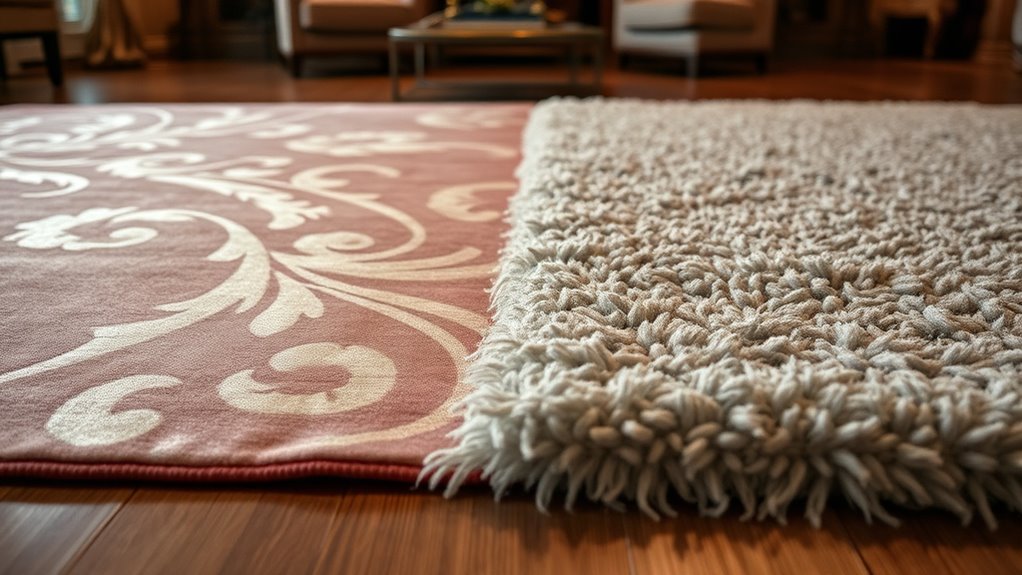
Silk and wool rugs each thrive in different environments, so choosing the right placement can enhance their durability and appearance. For silk rugs, avoid humid areas to prevent damage and preserve their sheen. Wool rugs are more versatile but should be placed where indoor air quality remains high to minimize dust buildup and allergic reactions. To optimize placement:
- Keep rugs away from direct sunlight to prevent fading and deterioration.
- Avoid high-traffic zones to reduce wear and tear.
- Use rugs in rooms with good ventilation to maintain air quality.
- Regularly clean and rotate rugs to reduce dust accumulation and allergens.
Proper placement not only preserves your rug’s beauty but also minimizes potential allergic reactions, ensuring a healthier living environment.
Cost Considerations and Investment Value
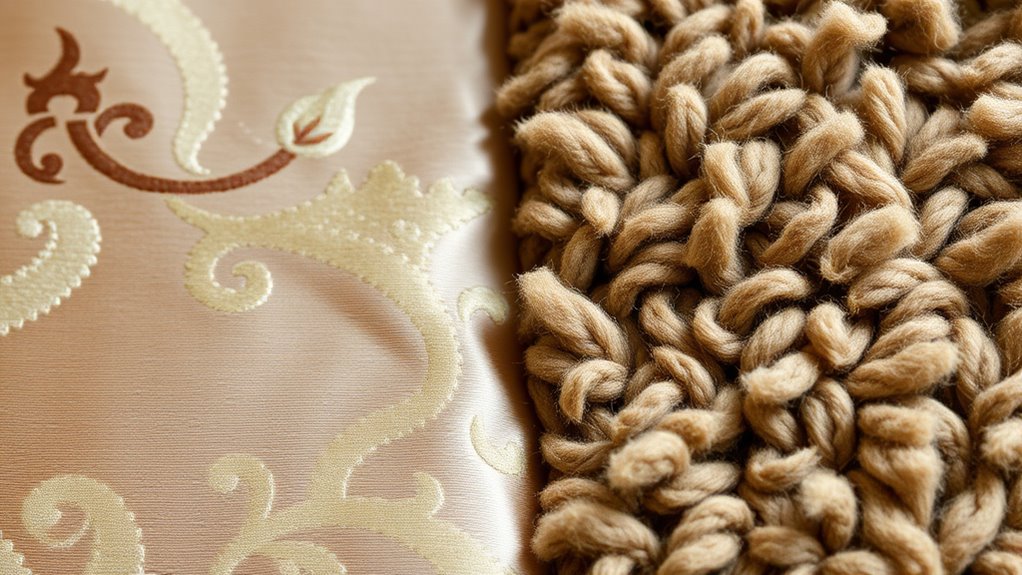
When weighing the costs of silk and wool rugs, it’s important to contemplate their long-term investment value. Silk rugs typically have higher installation costs due to their delicate craftsmanship and premium materials, but they can considerably boost your home’s resale value because of their luxurious appeal. Wool rugs usually come with lower installation expenses and are more durable, which helps preserve their appearance over time. While wool rugs may not fetch as high a resale value as silk, they tend to last longer, making them a smart investment for high-traffic areas. Ultimately, your choice depends on your budget and the value you place on aesthetics versus longevity. Both types can enhance your space, but considering initial costs and resale potential ensures a well-informed decision.
Maintenance Practices for Preserving Quality

Maintaining the beauty and durability of your rugs requires regular care and proper practices. To preserve color and prevent fraying, consider these key steps:
- Regular vacuuming with gentle settings to avoid fibers loosening or fraying.
- Rotate your rug every few months to ensure even wear and color preservation.
- Use rug pads to prevent slipping and reduce stress on edges, preventing fraying.
- Address spills immediately with blotting and mild cleaning to protect fibers and maintain sheen.
Frequently Asked Questions
Are Silk Rugs Hypoallergenic Compared to Wool Rugs?
When considering allergy concerns, silk rugs are generally less likely to trigger allergies compared to wool rugs because they tend to harbor less dust accumulation. Silk’s smooth surface resists dust and allergens better, making it hypoallergenic for sensitive individuals. However, regular cleaning is essential. Wool rugs can trap more dust and allergens, so if allergies are a concern, silk might be a better choice for maintaining a healthier environment.
How Do Silk and Wool Rugs Perform in High-Traffic Areas?
Even if you think delicate rugs can’t handle traffic, silk and wool are surprisingly resilient. Wool rugs excel in high-traffic areas with their traffic resilience and stain resistance, making them durable over time. Silk rugs, while luxurious, may show wear faster but can still perform well if you prioritize proper care. For busy spaces, wool offers a practical balance of durability and elegance.
Can Silk Rugs Be Used Outdoors or in Humid Environments?
You probably wonder if silk rugs can handle outdoor use or humid environments. Generally, silk rugs lack outdoor durability and aren’t suitable for humid conditions because moisture can damage their fibers and cause mold. If you want a rug for outdoor or humid spaces, look for durable materials like synthetic fibers or wool, which offer better humidity resistance and longevity in these environments. Silk rugs are best kept indoors and in dry areas.
Which Rug Type Is More Fire-Resistant, Silk or Wool?
When considering fire safety, wool rugs generally offer better flame retardancy than silk rugs. Wool is naturally fire-resistant, meaning it’s less likely to catch fire and helps contain flames if exposed. Silk, on the other hand, is more flammable and prone to burning quickly. If fire safety is a priority, choosing a wool rug provides enhanced flame retardancy and peace of mind in your home.
Do Silk and Wool Rugs Have Environmental Sustainability Differences?
Imagine choosing a rug that aligns with your eco values. Both silk and wool rugs can differ in sustainability; wool often comes from sheep raised with eco-friendly practices and sustainable sourcing, making it a greener choice. Silk production, however, may involve more chemical treatments and less sustainable methods. By selecting rugs crafted with eco-friendly practices, you support environmental health and reduce your carbon footprint.
Conclusion
Choosing between silk and wool rugs is like selecting a trusted friend—each offers unique beauty and strength. Wool rugs provide durability and cozy warmth, while silk rugs bring elegance and a delicate sheen. Think about your lifestyle and space to find your perfect match. With proper care, your rug will be a timeless treasure, weaving comfort and style into your home for years to come. Let your choice reflect your heart’s desire for beauty and resilience.
